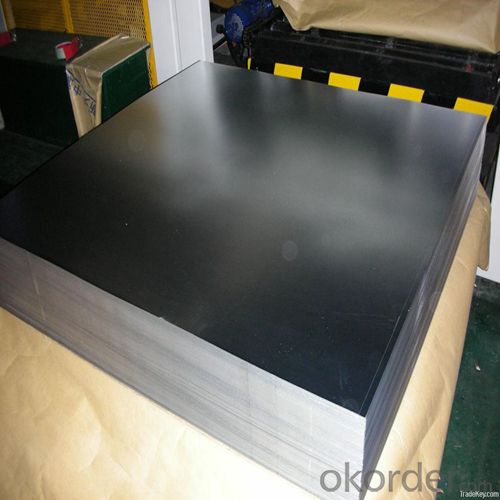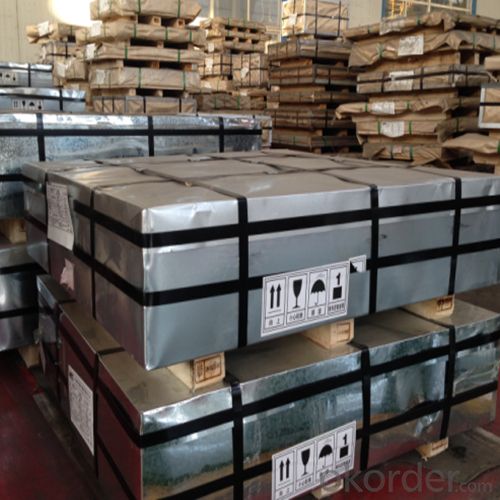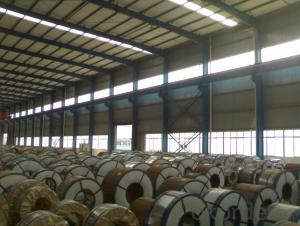Electrolytic Tinplate Coils and Sheets for Tin Cans Making
- Loading Port:
- Tianjin
- Payment Terms:
- TT OR LC
- Min Order Qty:
- 25 m.t
- Supply Capability:
- 7000 m.t/month
OKorder Service Pledge
OKorder Financial Service
You Might Also Like
1.Structure of Electrolytic Tinplate Coils and Sheets for Tin Cans Making Description
Electrolytic Tin Plate Coils and Sheets for Foods Metal Packaging, is one thin steel sheet with a coating of tin applied by electrolytic deposition. Tinplate made by this process is essentially a sandwich in which the central core is strip steel. This core is cleaned in a pickling solution and then fed through tanks containing electrolyte, where tin is deposited on both sides. As the strip passes between high-frequency electric induction coils, it is heated so that the tin coating melts and flows to form a lustrous coat.
2.Main Features of the Electrolytic Tinplate Coils and Sheets for Tin Cans Making
Appearance – Electrolytic Tin Plate is characterized by its beautiful metallic luster. Products with various kinds of surface roughness are produced by selecting the surface finish of the substrate steel sheet.
Paintability and printability – Electrolytic Tin Plates have excellent paintability and printability. Printing is beautifully finished using various lacquers and inks.
Formability and strength – Electrolytic Tin Plates have got very good formability and strength. By selecting a proper temper grade, appropriate formability is obtained for different applications as well as the required strength after forming.
Corrosion resistance – Tinplate has got good corrosion resistance. By selecting a proper coating weight, appropriate corrosion resistance is obtained against container contents. Coated items should meet 24 hour 5 % salt spray requirement.
Solderability and weldability – Electrolytic Tin Plates can be joined both by soldering or welding. These properties of tinplate are used for making various types of cans.
Hygienic – Tin coating provides good and non toxic barrier properties to protect food products from impurities, bacteria, moisture, light and odours.
Safe – Tinplate being low weight and high strength makes food cans easy to ship and transport.
Eco friendly – Tinplate offers 100 % recyclability.
Tin is not good for low temperature applications since it changes structure and loses adhesion when exposed to temperatures below – 40 deg C.
3.Electrolytic Tinplate Coils and Sheets for Tin Cans Making Images



4.Electrolytic Tinplate Coils and Sheets for Tin Cans Making Specification
Standard | ISO 11949 -1995, GB/T2520-2000,JIS G3303,ASTM A623, BS EN 10202
|
Material | MR,SPCC |
Thickness | 0.15mm - 0.50mm |
Width | 600mm -1150mm |
Temper | T1-T5 |
Annealing | BA & CA |
Coil Inner Diameter | 508mm |
Weight | 6-10 tons/coil 1~1.7 tons/sheets bundle |
Passivation | 311 |
Oil | DOS |
Surface | Finish,bright,stone,matte,silver |
5.FAQ of Electrolytic Tinplate Coils and Sheets for Tin Cans Making
- How are the Electrolytic Tin Plates specified?
The Electrolytic Tin Plates are specified as per the steel base, extent of tempering, the coating weight, annealing method and the surface finish.
- How many types there are for base steels?
The base steels are of three types: Type MR, L, D
- Q:What is the average lifespan of tinplate packaging?
- The average lifespan of tinplate packaging can vary depending on various factors such as the storage conditions, usage patterns, and level of care. However, with proper maintenance and handling, tinplate packaging can typically last for several years or even longer.
- Q:Can tinplate be used for packaging tobacco products?
- Yes, tinplate can be used for packaging tobacco products. Tinplate is a commonly used material for packaging due to its durability, resistance to corrosion, and ability to preserve the quality of the tobacco. It also provides a convenient and attractive packaging solution for consumers.
- Q:Can tinplate be used for construction materials?
- Yes, tinplate can be used for construction materials.
- Q:What are the different types of tinplate?
- There are several different types of tinplate, including single reduced (SR), double reduced (DR), and electrolytic tinplate (ETP).
- Q:Can tinplate be used for household appliances?
- Yes, tinplate can be used for household appliances. Tinplate is a type of steel coated with a thin layer of tin, which provides corrosion resistance and makes it suitable for various applications including household appliances such as cans, containers, and even electrical components.
- Q:What are the environmental impacts of using tinplate?
- The environmental impacts of using tinplate include deforestation, energy consumption, and pollution. The production of tinplate often requires large amounts of timber for the production of charcoal, resulting in deforestation and habitat destruction. Additionally, the manufacturing process of tinplate involves high energy consumption, which contributes to greenhouse gas emissions. Furthermore, the use of chemicals in the production and coating of tinplate can lead to water and soil pollution if not properly managed.
- Q:How is tinplate affected by exposure to UV light?
- Tinplate is not significantly affected by exposure to UV light since it is a highly durable material with good resistance to sunlight.
- Q:How does tinplate contribute to the overall ease of opening and closing packaging?
- Tinplate contributes to the overall ease of opening and closing packaging by providing a strong and durable material that can be easily shaped into various packaging forms. It offers excellent corrosion resistance, ensuring that the packaging remains intact and functional. Additionally, tinplate can be easily formed into easy-to-use closures, such as twist-off caps or pull tabs, enabling convenient opening and closing of the packaging without requiring any additional tools.
- Q:What are the different types of tinplate seams?
- The different types of tinplate seams include lap seams, double seam, triple seam, and lock seam.
- Q:How does tinplate perform in terms of aroma and flavor preservation?
- Tinplate performs exceptionally well in terms of aroma and flavor preservation. Its non-reactive properties ensure that the taste and smell of the food or beverage packed in tinplate containers remain intact, without any transfer of unwanted flavors or odors. Additionally, the tight seal provided by tinplate packaging prevents the entry of external elements that could affect the product's taste or smell, thus preserving the original aroma and flavor for an extended period of time.
1. Manufacturer Overview |
|
|---|---|
| Location | |
| Year Established | |
| Annual Output Value | |
| Main Markets | |
| Company Certifications | |
2. Manufacturer Certificates |
|
|---|---|
| a) Certification Name | |
| Range | |
| Reference | |
| Validity Period | |
3. Manufacturer Capability |
|
|---|---|
| a)Trade Capacity | |
| Nearest Port | |
| Export Percentage | |
| No.of Employees in Trade Department | |
| Language Spoken: | |
| b)Factory Information | |
| Factory Size: | |
| No. of Production Lines | |
| Contract Manufacturing | |
| Product Price Range | |
Send your message to us
Electrolytic Tinplate Coils and Sheets for Tin Cans Making
- Loading Port:
- Tianjin
- Payment Terms:
- TT OR LC
- Min Order Qty:
- 25 m.t
- Supply Capability:
- 7000 m.t/month
OKorder Service Pledge
OKorder Financial Service
Similar products
New products
Hot products
Hot Searches
Related keywords




























